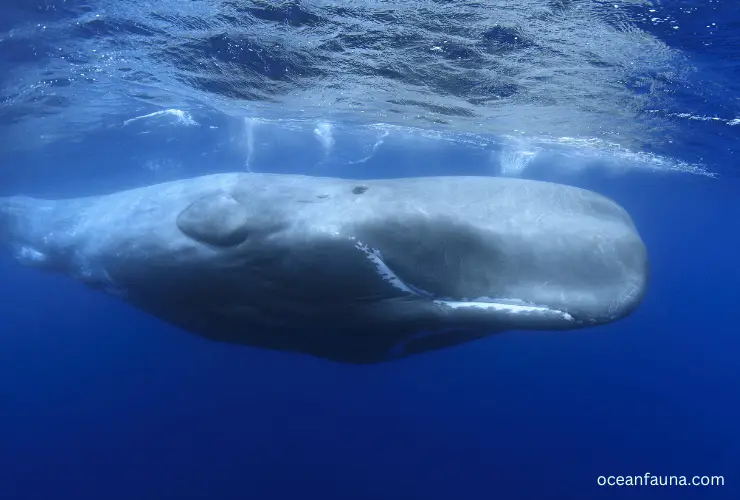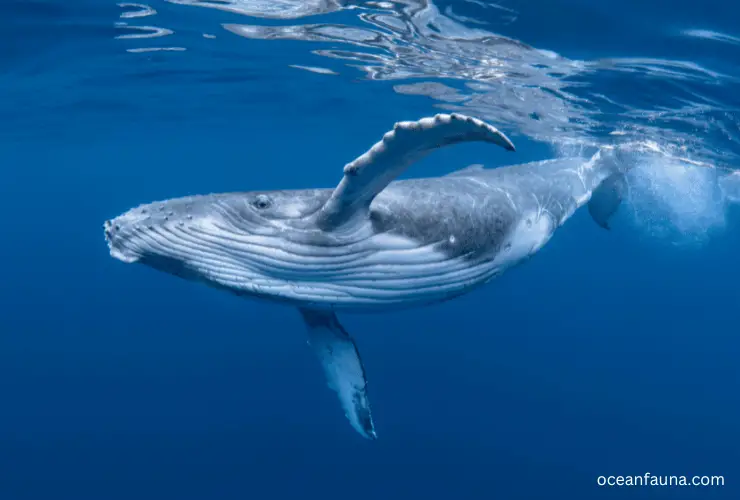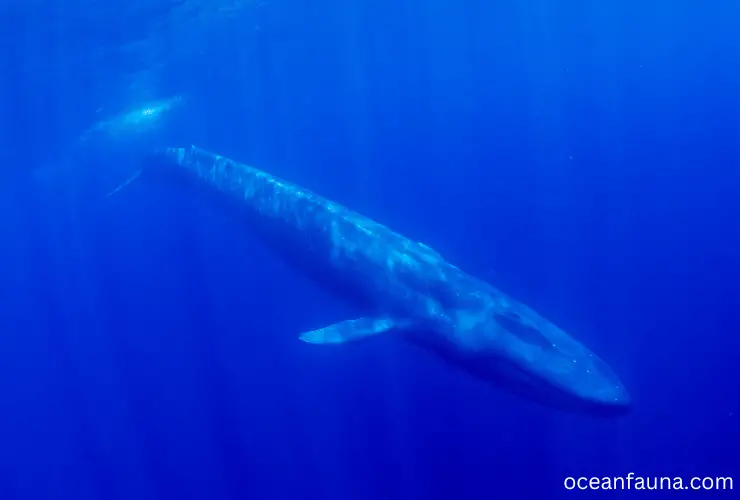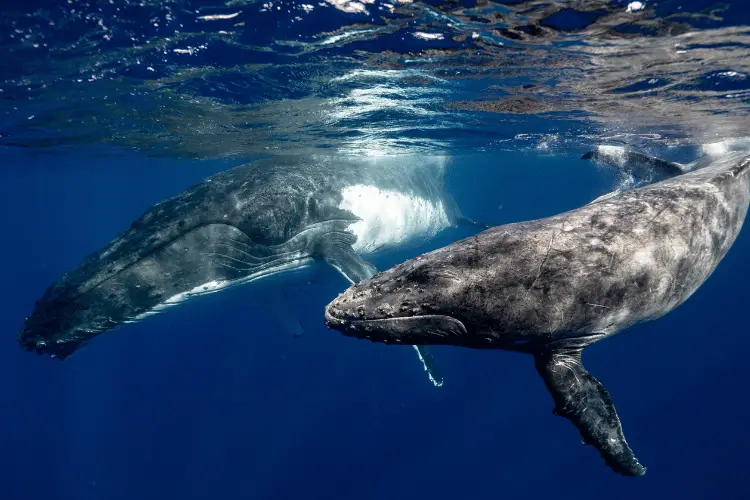Do whales lay eggs or give birth? Whales do not lay eggs for reproduction. Instead, they give birth to live young. This is because whales are marine mammals, not fish. Remember, all whale species give birth rather than laying eggs.
In this blog, I will discuss the whale’s reproduction system in more detail, including why whales give birth to live young, the gestation period, and the mother whale’s responsibilities once their calves are born.
Why Don’t Whales Lay Eggs?

Whales are one of the most fascinating animals on the planet, known for their enormous size, intelligence, and graceful movements in the water. Unlike most fish, which lay eggs, whales give birth to live young. There are several reasons why whales do not lay eggs, each of which has specific implications for their biology and behavior.
Evolutionary history
Whales do not lay eggs because they are descended from land mammals, which also give birth to live young. Whales are believed to have evolved from a group of four-legged, hoofed mammals called Mesonychids, which lived about 50 million years ago.
Over time, these animals adapted to living in the water, eventually developing the streamlined body shape, fins, and other features we associate with modern whales. Because their ancestors gave birth to live young, whales likely retained this reproduction method as they evolved.
Adaptation to the marine environment
Another reason whales do not lay eggs is that their young would not survive in the harsh marine environment. Unlike fish eggs, fertilized externally and left to develop independently, whale embryos need to be nurtured inside the mother’s body. This allows them to receive oxygen and nutrients directly from the mother’s bloodstream and protection from predators and other environmental threats.
Whale calves are born with a thick layer of fat and specific adaptations that allow them to survive in the cold, nutrient-poor waters where their parents live.
Reproductive strategies
Finally, whales may not lay eggs because it is more advantageous for them to give birth to live young. This can be seen in the way that different whale species reproduce. Some whales, such as the humpback whale, engage in complex courtship and mating behaviors, which may help them find the best possible mate and increase their chances of reproductive success.
Other species, such as toothed whales, tend to have shorter gestation periods and produce larger litters, which is beneficial in the highly competitive environment of the sea.
Both of these strategies would be more difficult to accomplish if whales laid eggs, as it would require leaving the eggs unattended for long periods and exposing them to environmental stressors such as temperature changes and predation.
How Do Whales Mate? Anatomical Analysis

Whales have sexual organs just like humans, and their mode of reproduction is quite fascinating.
Male whales possess a penis, which can measure up to several feet in length, depending on the species. Meanwhile, female whales have a vagina that leads to their reproductive tract. During mating, the male’s penis is inserted into the female’s vagina, and they engage in what is known as internal fertilization.
Whales mate underwater, usually in a belly-to-belly position, with either one or both partners moving.
Interestingly, the act of mating can be quite acrobatic with some species. They require the male to perform complex maneuvers to reach the female’s genital opening. It’s almost like watching a synchronized swimming routine but with a more important outcome.
What Is the Gestation Period of Whales?
Whales, fully aquatic mammals, have a unique birthing process, unlike land-based animals that lay eggs or give birth on land. They give birth to live young by carrying their offspring in their wombs like other mammals.
However, their process is different adapted to their life in water. Female whales birth their calves in the ocean, often tail first to prevent drowning.
Regarding gestation, each whale species has a different time frame. The gestation period is the time from fertilization to birth. Whale gestation periods vary by species. Check out the table below.
| Whale Species | Gestation Period |
| Minke Whale | 10 months |
| Narwhal Whale | 13 – 16 months |
| Sperm Whale | 14 – 16 months |
| Gray Whale | 12 – 13 months |
| Humpback Whale | 11 |
| Beluga Whale | 12 – 14 months |
| Blue Whale | 10 – 12 months |
| Bowhead Whale | 13 – 14 months |
| Right Whale | 12 months |
| Fin Whale | 11 months |
| Sei Whale | 11 – 13 months |
| Southern Right Whale | 12 months |
| Dwarf Sperm Whale | 274 days |
| Short-finned Pilot Whale | 15 months |
| North Atlantic Right Whale | 12 months |
| Long-finned Pilot Whale | 14 – 16 months |
| Northern Bottlenose Whale | 12 months |
| Sowerby’s Beaked Whale | 12 months |
| Baird’s Beaked Whale | 17 months |
Whale gestation periods are longer than many other mammals of similar size. Longer gestations help ensure calves are fully developed for underwater life.
How Do Whales Give Birth?
Whales have unique reproductive processes. Their birthing is entirely different from other mammals. Whales, unlike land mammals, have their live calves underwater. The calves grow inside the mother. After the gestation period, calves are born through a specialized canal.
During birth, the calf usually emerges head first to avoid drowning. The mother positions herself vertically, head up, to guide the calf to the surface for its first breath. Depending on the species, this process varies in duration, from hours to days.
Post-birth, the mother and newborn immediately bond. The calf starts suckling from mammary glands under the pectoral fins. Whale milk, rich in nutrients and fats, is vital for the calf. It needs to quickly gain weight, often doubling in size in a year.
The mother’s size generally determines the calf’s size. Newborn calves vary in length from 13-16 feet, based on the whale species. For instance, a humpback calf might weigh a ton at birth, while a gray whale’s calf could weigh about 300 pounds.
Does a Mother Whale Take Care of Her Calf?

A mother whale dedicates herself to caring for her calf. Nurturing their young is central to their lives. They use instinct and knowledge to ensure their calves’ survival. This bond is crucial for the calf’s survival and development.
Cetacean mothers are remarkable in their parenting. They spend months, even years, raising their young. The mother teaches her calf essential survival skills like hunting, navigating, and socializing. She feeds her calf nutrient-rich milk to promote healthy growth.
The level of care a mother whale provides is extraordinary. She stays close, using her body to shield the calf from predators and harsh weather. She forms a special bond, communicating through sounds, body language, and touch. Her actions comfort and safeguard the calf while boosting its cognitive and social skills.
FAQs
Do blue whales lay eggs?
Blue whales, like all other whale species, do not lay eggs. They give birth to live young.
Do whales mate for life?
No, whales do not mate for life. Whales are not monogamous and do not form bonds with their mating partners. Depending on the species, they can have multiple mates throughout their lifetime.
Do killer whales lay eggs?
Killer whales belong to the dolphin family and are marine mammals. Unlike egg-laying creatures, they give birth to live young and exhibit intricate courtship behaviors.
Do all whales give birth?
Yes, all the whales give birth to live young since they are mammals. They do not lay eggs. However, some species of whales, such as the killer whale and the long-finned pilot whale, have been observed adopting orphaned or lost calves from different pods. This behavior is known as alloparenting and shows the strong bonds within these social animals.
Conclusion
Now, you have a comprehensive understanding of the reproductive system of whales. There is often confusion among people who mistakenly believe that whales lay eggs like fish. However, this is not the case. Whales do not lay eggs; instead, they give birth to live young like other mammals.

